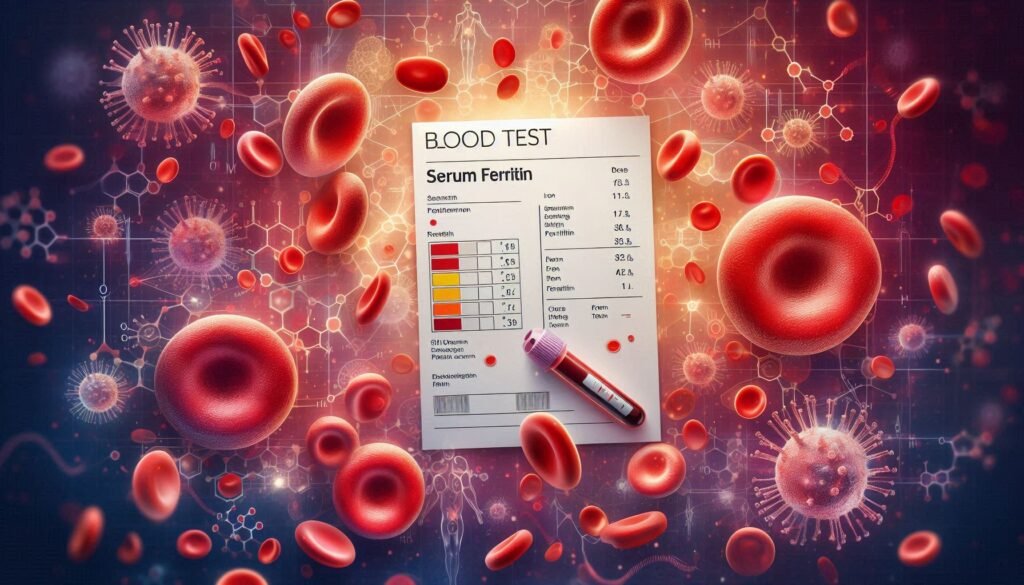Understanding serum ferritin levels is crucial for anyone navigating the complexities of polycythemia. This protein acts as a key player in iron metabolism and storage, revealing much about our body’s health. With rising interest in conditions like polycythemia—characterized by an increased number of red blood cells—it’s essential to explore how ferritin levels can inform diagnosis and treatment.
Whether you’re a patient or healthcare professional, knowledge of how ferritin interacts with various forms of polycythemia can significantly impact management strategies. By uncovering this connection, we aim to provide insights that not only enhance understanding but also guide better clinical decisions. Join us as we delve into the fascinating world of serum ferritin and its implications for those facing polycythemia challenges.

The Role of Ferritin in Iron Metabolism and Storage
Ferritin is a crucial protein responsible for storing iron in the body. It acts as a buffer against iron deficiency and overload, ensuring that this vital mineral is available when needed. By binding to excess iron, ferritin prevents potential toxicity while facilitating its release during periods of increased demand.
This protein plays a significant role in maintaining overall health. Iron is essential for red blood cell production and energy metabolism, impacting everything from cognitive function to immune responses. Ferritin levels provide valuable insights into the body’s current iron status.
In healthy individuals, ferritin levels fluctuate based on dietary intake and physiological needs. Factors such as growth spurts, menstruation, or illness can affect these levels significantly. Monitoring serum ferritin helps assess whether an individual has adequate iron stores or if they are at risk of deficiency.
Understanding ferritin’s function aids in diagnosing various conditions related to abnormal iron metabolism. This knowledge is particularly important for managing disorders like polycythemia where maintaining balanced iron levels becomes critical.
Normal Serum Ferritin Levels: Variations by Age, Gender, and Health Status
Normal serum ferritin levels can vary significantly based on several factors, including age, gender, and overall health. Typically, adult males exhibit higher levels of ferritin than females due to differences in iron requirements related to menstruation and pregnancy.
For children and adolescents, ferritin levels fluctuate as they grow. Younger individuals often have lower baseline levels that gradually increase with age. By late adolescence, these values may approach those seen in adults.
Health status also plays a critical role in determining normal ranges for ferritin. Individuals with chronic diseases or inflammation may experience elevated levels due to the acute phase response. Conversely, conditions that lead to iron deficiency can result in notably low serum ferritin readings.
Understanding these variations is essential for accurate diagnosis and treatment planning. Healthcare providers must consider an individual’s demographic background when interpreting test results to provide appropriate care tailored to their specific needs.
The Relationship Between Serum Ferritin and Polycythemia
Serum ferritin levels play a crucial role in understanding polycythemia, a condition characterized by an increased number of red blood cells. Ferritin serves as the primary storage form of iron in the body, reflecting overall iron availability. Analyzing serum ferritin can provide insights into both erythropoiesis and iron metabolism.
In patients with polycythemia vera, a specific type of polycythemia driven by genetic mutations, elevated ferritin levels are often observed. This elevation may indicate not only enhanced red blood cell production but also underlying inflammation or tissue hypoxia. Understanding these relationships is essential for effective management.
Conversely, secondary forms of polycythemia might present with varying serum ferritin levels depending on the underlying cause—like chronic hypoxia or tumors producing erythropoietin. In such cases, low ferritin could signify concurrent iron deficiency amidst elevated red blood cell counts.
Thus, evaluating serum ferritin provides critical context when diagnosing and treating different types of polycythemia. It aids healthcare professionals in tailoring treatment strategies to address unique patient needs effectively.
Interpreting Ferritin Levels in Different Types of Polycythemia
Interpreting ferritin levels in polycythemia requires understanding the type of condition present. Polycythemia vera, a primary form, is characterized by increased red blood cell production due to mutations in bone marrow cells. In this case, serum ferritin levels may often be elevated or normal. This can indicate adequate iron stores despite the excess red cell mass.
On the other hand, secondary polycythemia arises from external factors like hypoxia or tumors producing erythropoietin. Ferritin levels might vary greatly depending on overall health and underlying conditions. These patients may display high ferritin due to chronic inflammation or low levels reflective of concurrent iron deficiency.
It’s essential to evaluate ferritin not only as an isolated marker but alongside hemoglobin and hematocrit values. The complete clinical picture aids in crafting personalized management plans for each individual.
Regular monitoring helps track changes over time and informs decisions regarding treatment options and interventions necessary for optimal care.
High Ferritin Levels: Implications for Polycythemia Management
High serum ferritin levels can be a significant concern for individuals with polycythemia. Elevated ferritin often indicates an increased iron load in the body, which can complicate the management of this condition. Patients may experience symptoms like headaches, dizziness, or fatigue due to excessive red blood cell production.
In polycythemia vera (PV), high ferritin levels are commonly associated with disease progression. Increased iron levels can lead to potential complications such as thrombosis and cardiovascular issues. Thus, careful monitoring is essential for effective management.
Treatment strategies may involve therapeutic phlebotomy to reduce both red blood cell mass and excess iron stores. This approach aims not only to alleviate symptoms but also to lower the risk of severe health problems linked to elevated ferritin.
Healthcare providers should regularly assess serum ferritin alongside other markers when managing patients with polycythemia. This comprehensive strategy ensures that treatment remains tailored and responsive to individual patient needs while addressing any underlying concerns related to iron overload.
Low Ferritin Levels: When Iron Deficiency Complicates Polycythemia
Low ferritin levels can pose significant challenges for individuals with polycythemia. While polycythemia typically involves increased red blood cell production, the presence of low ferritin suggests an underlying iron deficiency. This condition complicates management and may lead to additional health issues.
Iron is crucial for hemoglobin synthesis. When ferritin is low, it indicates that the body’s iron stores are depleted. This situation can result in symptoms such as fatigue, weakness, and pale skin—factors that already overlap with those caused by polycythemia itself.
Patients experiencing both conditions may struggle more than others who have either alone. The body’s attempts to compensate through erythropoiesis can be hindered when there’s inadequate iron available. Consequently, this dual diagnosis necessitates careful monitoring and evaluation.
Addressing low ferritin levels becomes crucial in managing overall health effectively. Healthcare providers often recommend dietary adjustments or supplements to restore optimal iron levels while keeping a close watch on hematocrit values for better outcomes.
Factors Affecting Serum Ferritin Levels: Ensuring Accurate Interpretation
Several factors can influence serum ferritin levels, making accurate interpretation crucial for diagnosis and management. Inflammation plays a significant role. Conditions such as infections or autoimmune diseases can elevate ferritin levels independently of iron status due to its acute-phase reactant properties.
Liver function is vital in determining ferritin levels. Liver disease can lead to increased production and storage of ferritin, skewing results. Additionally, chronic alcohol consumption may affect liver health and consequently alter ferritin readings.
Age and sex also contribute to variations in serum ferritin levels. Generally, women tend to have lower baseline values than men due to menstruation until menopause alters this dynamic.
Nutritional factors cannot be overlooked. A diet deficient in iron may lead to low ferritin levels despite the presence of other conditions that raise it artificially. Understanding these influences ensures better clinical decision-making when interpreting test results related to polycythemia.
The Impact of Phlebotomy Treatment on Ferritin Levels in Polycythemia
Phlebotomy is a common treatment for managing polycythemia, particularly in conditions like polycythemia vera. This procedure involves the removal of blood to decrease red blood cell mass and improve circulation. One key effect of phlebotomy is its influence on serum ferritin levels.
As blood is drawn, iron stores are also reduced since hemoglobin contains substantial amounts of iron. Consequently, patients might experience a drop in their ferritin levels following frequent phlebotomy sessions. Monitoring these changes becomes essential for proper management.
While lowering elevated ferritin could be beneficial in some cases, excessive depletion can lead to iron deficiency anemia. It’s crucial to find a balance between reducing hematocrit levels and maintaining adequate iron stores for overall health.
Regular assessment of serum ferritin after each phlebotomy session helps healthcare providers tailor treatment plans effectively. This approach ensures that patients receive optimal care while avoiding complications related to both high and low ferritin levels.
Monitoring Ferritin Levels: Frequency and Importance in Long-term Care
Regular monitoring of serum ferritin levels is vital for individuals with polycythemia. Ferritin serves as an important indicator of the body’s iron stores, which can significantly affect overall health. For those managing this condition, tracking these levels helps ensure that treatment plans remain effective.
Health care providers typically recommend routine testing to evaluate changes in ferritin concentrations over time. This frequency can vary based on individual circumstances but often occurs every three to six months. Frequent assessments allow for timely interventions when fluctuations occur.
Understanding ferritin levels aids in recognizing potential complications early. High or low ferritin can signal underlying issues requiring adjustment in therapy or lifestyle modifications.
Moreover, consistent monitoring supports informed decisions about dietary choices and supplementation needs related to iron intake. As patients engage actively in their health management, they gain insights into how their bodies respond to treatments and necessary adjustments moving forward.
Emerging Research: New Insights into Ferritin’s Role in Polycythemia
Emerging research continues to shed light on the intricate role of ferritin in polycythemia. Scientists are exploring how variations in serum ferritin levels might influence disease progression and treatment outcomes. Recent studies suggest that elevated ferritin may not only indicate iron overload but could also serve as a biomarker for inflammation associated with certain types of polycythemia.
Additionally, advances in technology are helping researchers better understand the mechanisms behind ferritin’s function within erythropoiesis—the production of red blood cells. This could lead to targeted therapies that manage both iron levels and hematocrit effectively, offering hope for improved patient care.
Furthermore, genetic factors influencing serum ferritin levels and their impact on individual responses to treatments are being investigated. These insights can pave the way for personalized approaches in managing polycythemia, optimizing therapy based on unique patient profiles.
As the scientific community delves deeper into these connections, we can anticipate more refined strategies aimed at balancing iron storage while controlling red cell mass. Staying informed about these developments will be crucial for healthcare providers and patients alike in navigating this complex condition effectively.


